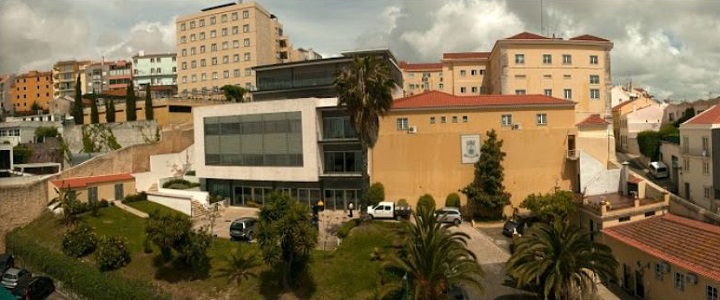|
Instituto Hidrográfico
|

|
|
Type of Research Institution
|
| | Intergovernmental | | | Academic | |  | Governmental, national | | | Private | | | Governmental, local | | | Charity / Foundation |
|
|
|
Address : Rua das Trinas 49
1249-093 Lisbon
PORTUGAL |
|
Phone :
+351 210 943 011
|
|
|
|
Director :
Admiral Ramalho Marreiros
|
|
Contact person :
|
|
|
|
|
Number of permanent staff
|
| | Scientists (with doctorate/ PhD) : 12 | | | others : 65 |
|
|
|
Type of Activities
|
| | Pure research | | | Academic | |  | Applied research | |  | Education / Outreach | |  | Long-term monitoring | |  | Policy / Planning / Consultancy | | | Technology for environmental applications | | | Conservation & Protection |
|
|
|
Main fields of research (at present - 6 max)
|
| high-resolution seabed mapping, satellite-based hydrography, environmental monitoring concerning microplastics and pollution by oil spills, sediment transport and sea bottom characteristics, ocean dynamics |
|
|
|
Main research collaborations at international level (at present)
|
| * SHOM, ICES, IOC-UNESCO (GOOS, EuroGOOS), International Hydrographic Organization, Instituto Hidrográfico de la Marina - Armada Española |
|
|
|
Ongoing long-term monitoring programs
|
* The Portuguese Seabed Mapping
*
The Portuguese EEZ Monitoring and Operational Forecasting System (MONIZEE) of the ocean
*
Characterization of the Portuguese seabed sediments |
|
|
|
Total area dedicated to research (m2)
|
|
|
|
|
Conference room
|
| no |  | yes (number of seats : 112 ) |
|
|
|
Research vessel(s)
|
 | less than 12 m in length; number of vessels : 5 |  | more than 12 m in length; number of vessels : 6 | | Brief description of vessels and on board scientific equipment :
“Trinas” and “Azinheira”: 8,5 m, hydrographic port surveys with single beam echosounders system
“Gaivota”, “Mergulhão” and “Cagarra”: 8,5 m, hydrographic port surveys with multibeam systems and collecting water samples
“Atlanta” and “Fisália”: 15,2 m, Coastal and port hydrographic surveys with multibeam systems, urveys with side-scan sonars, light seismic surveys (continuous reflection), collecting water samples
“Andrómeda” and “Auriga” (Navy Ships): 31,5m, ship prepared for installation of several portable scientific equipment (e.g. side-scan sonar; light seismic; bottom sample pickers; ROV, etc.)
“D. Carlos I” and “Almirante Gago Coutinho” (Navy Ships): 68,7 m, multi-beam echosounders of medium and deep waters, dynamic positioning system, collecting water and sediment samples, operating multi-parameter buoys |
|
|
|
Other major research facilities and equipment
|
* In this building, operate the governing bodies, the technical bodies (Navigation Division, Hydrography Division, Oceanography Division, Marine Geology Division, Marine Chemistry and Pollution Division and the Technical-Scientific Data Management Center), documentation, financial and logistical support services, the School of Hydrography and Oceanography and the Chemistry and Pollution of the Marine and Sedimentology laboratories
* Field Instrumentation: Oceanographic buoys; ROV; Smith McIntyre grabs; Vertical sediment samplers – Corers (vibrocorer, box corer, gravity corer, piston corer and multi-tube); Superficial pumps; Rosette samplers (with Niskin bottles and CTD probes); Sea level recorders; Wave Recorders; Current meters and Current profilers; Multiparametric probes; Drifters; LISST probes; Magnetometers; High resolution seismic profilers (Chirp, SPARKER and BOOMER); Side-Scan Sonars, etc. |
|
|
|
Ecosystem types available nearby
|
| No direct access to sea |  | Direct access to brackish / estuarine waters |
|
|
|
Areas of taxonomic expertise
|
|
|
|
|
Specimen collections
|
| yes |  | no |
|
|
|
Hosting facilities for visiting scientists
|
 | yes | | no |
|
|
|
Training courses
|
 | yes | | no | |
Specialization of Hydrographic Engineering
Specialization Course in Hydrography (CAT A)
Hydrography Technical Course (CAT B)
Curricular Internships (marine sciences) |
|
|
|
Capacity and brief description of library
|
| The Hydrographic Institute has a specialized Library with more than 20 000 works, mainly related to the study of Marine Sciences.
The main areas of interest are marine data management, hydrography, marine geology, oceanography, navigation and marine chemistry and pollution.
The Library reinforces its collection annually through the acquisition and exchange of relevant monographs for its area of specialization and maintains a wide range of periodical reference publications (Seaways, Journal of Marine Research, Journal of Geophysical Research, Safety at Sea International, Navigation or Hydro International), some of which are online |
|
|
 CIESM GUIDE OF COASTAL INSTITUTES IN THE MEDITERRANEAN AND ADJACENT SEAS CIESM GUIDE OF COASTAL INSTITUTES IN THE MEDITERRANEAN AND ADJACENT SEAS
Last update : 09/03/2020
|

 CIESM GUIDE OF COASTAL INSTITUTES IN THE MEDITERRANEAN AND ADJACENT SEAS
CIESM GUIDE OF COASTAL INSTITUTES IN THE MEDITERRANEAN AND ADJACENT SEAS



